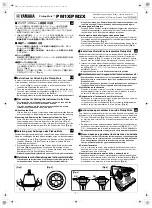
137
6
F
2
S
0
7
8
9
If no message is shown on the LCD, this means that the failure location is either in the DC power
supply circuit or in the microprocessors mounted on the SPM module. Then check the
"ALARM" LED. If it is off, the failure is in the DC power supply circuit. If it is lit, open the relay
front panel and check the LEDs mounted on the SPM module. If the LED is off, the failure is in
the DC power supply circuit. If the LED is lit, the failure is in the microprocessors.
In the former case, check if the correct DC voltage is applied to the relay.
If so, replace the IO1 module mounting the DC/DC converter and confirm that the "ALARM"
LED is turned off.
In the latter case, replace the SPM module containing the processors and confirm that the
"ALARM" LED is turned off.
When a failure is detected during regular testing, it will not be difficult to identify the failed
module to be replaced.
Note:
When a failure or an abnormality is detected during the regular test, confirm the following
first:
- Test circuit connections are correct.
- Modules are securely inserted in position.
- Correct DC power voltage with correct polarity is applied and connected to the correct
terminals.
- Correct AC inputs are applied and connected to the correct terminals.
- Test procedures comply with those stated in the manual.
6.7.3 Replacing Failed Modules
If the failure is identified to be in the relay module and the user has spare modules, the user can
recover the protection by replacing the failed modules.
Repair at the site should be limited to module replacement. Maintenance at the component level
is not recommended.
Check that the replacement module has an identical module name (VCT, SPM, IO1, IO2, etc.)
and hardware type-form as the removed module. Furthermore, the SPM module should have the
same software name.
The module name is indicated on the bottom front of the relay case. The hardware type-form is
indicated on the module in the following format:
Module name Hardware type-form
VCT
G1PC2-
SPM
G1SP
-
IO1
G1IO1-
IO2
G1IO2-
IO3
G1IO3-
HMI
--
Summary of Contents for GRT100 Series
Page 142: ... 141 6 F 2 S 0 7 8 9 Appendix A Block Diagram ...
Page 144: ... 143 6 F 2 S 0 7 8 9 Appendix B Signal List ...
Page 159: ... 158 6 F 2 S 0 7 8 9 ...
Page 160: ... 159 6 F 2 S 0 7 8 9 Appendix C Variable Timer List ...
Page 162: ... 161 6 F 2 S 0 7 8 9 Appendix D Binary Output Default Setting List ...
Page 165: ... 164 6 F 2 S 0 7 8 9 ...
Page 166: ... 165 6 F 2 S 0 7 8 9 Appendix E Details of Relay Menu and LCD and Button Operation ...
Page 174: ... 173 6 F 2 S 0 7 8 9 Appendix F Case Outline Flush Mount Type Rack Mount Type ...
Page 179: ... 178 6 F 2 S 0 7 8 9 ...
Page 180: ... 179 6 F 2 S 0 7 8 9 Appendix G External Connections ...
Page 185: ... 184 6 F 2 S 0 7 8 9 ...
Page 200: ... 199 6 F 2 S 0 7 8 9 ...
Page 201: ... 200 6 F 2 S 0 7 8 9 Appendix J Return Repair Form ...
Page 205: ... 204 6 F 2 S 0 7 8 9 Customer Name Company Name Address Telephone No Facsimile No Signature ...
Page 206: ... 205 6 F 2 S 0 7 8 9 ...
Page 207: ... 206 6 F 2 S 0 7 8 9 Appendix K Technical Data ...
Page 220: ... 219 6 F 2 S 0 7 8 9 ...
Page 221: ... 220 6 F 2 S 0 7 8 9 Appendix M Symbols Used in Scheme Logic ...
Page 224: ... 223 6 F 2 S 0 7 8 9 ...
Page 225: ... 224 6 F 2 S 0 7 8 9 Appendix N Implementation of Thermal Model to IEC60255 8 ...
Page 228: ... 227 6 F 2 S 0 7 8 9 ...
Page 229: ... 228 6 F 2 S 0 7 8 9 Appendix O IEC60870 5 103 Interoperability and Troubleshooting ...
Page 241: ... 240 6 F 2 S 0 7 8 9 Appendix P Modbus Interoperability ...
Page 255: ... 254 6 F 2 S 0 7 8 9 ...
Page 256: ... 255 6 F 2 S 0 7 8 9 Appendix Q Inverse Time Characteristics ...
Page 259: ... 258 6 F 2 S 0 7 8 9 ...
Page 260: ... 259 6 F 2 S 0 7 8 9 Appendix R Failed Module Tracing and Replacement ...
Page 266: ... 265 6 F 2 S 0 7 8 9 Appendix S Ordering ...
Page 269: ... 268 6 F 2 S 0 7 8 9 3 1 Oct 2 2017 Republished under spin off company ...
Page 270: ......
















































